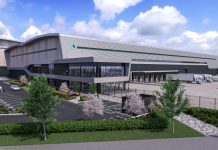The outlook for 2015 is a positive one, but creating built environment for East Midlands SMEs presents key challenges for the industry according to Innes England’s Stuart Waite.
We are seeing a marked increase in the number of property requirements from SME businesses right across the region. The challenge in 2015 is undoubtedly (a well reported) lack of availability across all size ranges and grades of stock.
This is due to the combined effect of low levels of new development since the economic downturn and generally strong/improving levels of take up. The economic outlook for 2015 is generally good; interest rates are set to remain low, wage growth is higher than inflation and falling oil prices appear to be impacting positively. Whilst there are challenges, this is clearly translating into renewed business confidence and thus impacting positively on the commercial property sector.
In Derby, activity during 2014 was dominated by transactions on poorer quality second-hand space, which accounted for 81% of total take up. We calculated that “Grade A” space accounted for only 17% of total availability at the end of 2014.
From a wider economic perspective, RBS recently announced its annual growth figures on a regional and city level and the East Midlands had a strong 2014 – the third best performing region in the UK after London and the North West, showing strong growth of 3%, above the national average of 2.85%. This factor could deliver further job creation and all of these figures point to a requirement for high quality business space.
There is undoubtedly investor appetite for the regions. We are speaking with a number of developers and investors active in the sector and funding is available to deliver schemes that could provide high quality space for SME’s, however, these schemes are often financially unviable (largely due to increasing build costs). The time is right to capitalise on this trend, with London and the South East ‘overheating’ – private and institutional wealth is filtering through into the regions where there is perceived value away from the overly competitive South East market.
SME’s account for a large proportion of our economy and the provision of suitable accommodation for these companies as they expand is vital in aiding our continued recovery. SME’s are having to consider new build options and these buildings are not deliverable at second-hand prices/rents. This lack of supply is impacting on prices and rents achieved on good quality second hand accommodation, which are probably 10 to 15% ahead of figures recorded as recently as nine to 12 months ago.
Occupiers unfortunately need to accept that rental and capital values will need to increase above previously recorded prime levels to aid viability of schemes, which can cater for SME demand. This is certainly the case when looking at sub-50,000 sq ft buildings where there has been little new build activity across the region. This dynamic isn’t as much of a concern when catering for ‘big box’ logistics demand, where a buoyant investment market has seen a number of the financial institutions look to the regions for value, which significantly aids development viability, along with blue chip covenants and economies of scale reducing build costs on a rate per sq ft basis.
There is evidence of this in the local market, with global developer Goodman forming a strategic development partnership with Anglesea Capital that will initially deliver 930,000 sq ft of logistics space in 2015, with a 323,895 warehouse to be speculatively built in Derby on the successful Derby Commercial Park, with work on site likely in Q2 2015. This follows a 632,000 sq ft letting, agreed in 2013, to Kuehne + Nagel for its Heineken Drinkflow Logistics contract, on the same site, which saw the building completed by Goodman in 2014 and subsequently sold to an institutional investor. The centre is a centralised stockholding point for brands including Foster’s, Strongbow, Bulmers, Heineken, Kronenbourg 1664 and Desperados.
Derby is the home to global giants Rolls-Royce, Toyota and Bombardier (the ‘big three’), as well as a strong supply chain cluster in advanced engineering. A commonly reported figure shows that 12% of Derby’s workforce is employed in hi-tech functions – four times the national average and double that of other hi-tech cities Cambridge, Bristol and Reading. A third of the East Midlands engineering/manufacturing workforce is in Derby, with over 45,000 employees working in the sector.
It’s not just the supply chain to the big three that drives the industrial/manufacturing sector in Derby. There are other innovative companies which were born and continue to flourish in the city including HUUB Design, situated on Sinfin Lane, which designs, engineers and sells high performance wetsuits to elite (and not so elite) triathletes, including the Brownlee brothers.
Development is largely about managing risk, and undoubtedly supply and demand dynamics are right, interest rates are set to remain low and occupier confidence is improving, but viability still remains a huge issue, predominantly due to increasing build costs. Construction costs continue to rise due to materials and skill shortages. I am sure there is a longer term solution to this problem but certainly not one that will lead to a reduction in build costs in the short term.
It may be that we need to see more creative ways of funding such developments, including grant funding and ‘soft’ loans through Local Authorities/LEP’s in order to assist with viability. This is happening in respect of large-scale projects such as Infinity Park, providing essential infrastructure funding for a project of significant importance for the city and the region. This will create much needed business space and an environment for hi-tech design and engineering companies to flourish, but more is needed.
Profit is not a dirty word. The blue chip companies and supply chain we want to see in the city need to show profitability, as do developers, and we need to see speculative development in order to cater for the current and projected demand for good quality light industrial/distribution facilities in order to retain and, indeed, attract these highly sought after businesses to the city and the wider region.



















